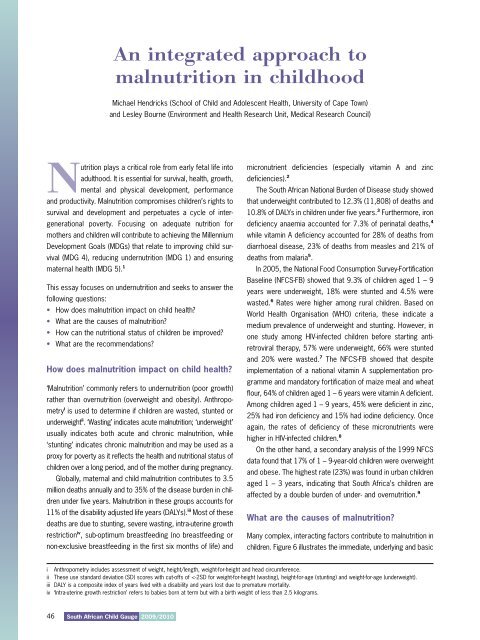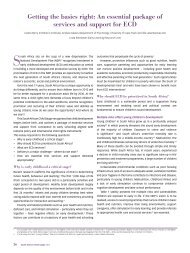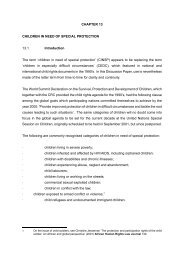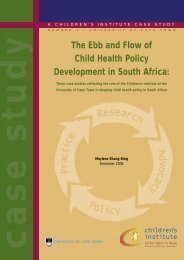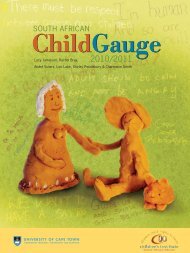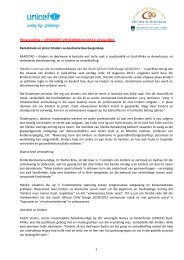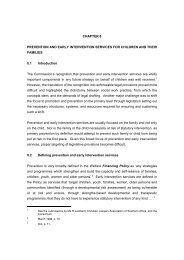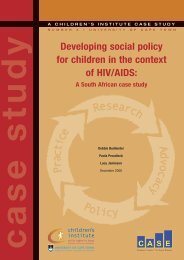South African Child Gauge 2009/2010 - Children's Institute
South African Child Gauge 2009/2010 - Children's Institute
South African Child Gauge 2009/2010 - Children's Institute
Create successful ePaper yourself
Turn your PDF publications into a flip-book with our unique Google optimized e-Paper software.
An integrated approach to<br />
malnutrition in childhood<br />
Michael Hendricks (School of <strong>Child</strong> and Adolescent Health, University of Cape Town)<br />
and Lesley Bourne (Environment and Health Research Unit, Medical Research Council)<br />
Nutrition plays a critical role from early fetal life into<br />
adulthood. It is essential for survival, health, growth,<br />
mental and physical development, performance<br />
and productivity. Malnutrition compromises children’s rights to<br />
survival and development and perpetuates a cycle of intergenerational<br />
poverty. Focusing on adequate nutrition for<br />
mothers and children will contribute to achieving the Millennium<br />
Development Goals (MDGs) that relate to improving child survival<br />
(MDG 4), reducing undernutrition (MDG 1) and ensuring<br />
maternal health (MDG 5). 1<br />
This essay focuses on undernutrition and seeks to answer the<br />
following questions:<br />
• How does malnutrition impact on child health?<br />
• What are the causes of malnutrition?<br />
• How can the nutritional status of children be improved?<br />
• What are the recommendations?<br />
How does malnutrition impact on child health?<br />
‘Malnutrition’ commonly refers to undernutrition (poor growth)<br />
rather than overnutrition (overweight and obesity). Anthropometry<br />
i is used to determine if children are wasted, stunted or<br />
underweight ii . ‘Wasting’ indicates acute malnutrition; ‘underweight’<br />
usually indicates both acute and chronic malnutrition, while<br />
‘stunting’ indicates chronic malnutrition and may be used as a<br />
proxy for poverty as it reflects the health and nutritional status of<br />
children over a long period, and of the mother during pregnancy.<br />
Globally, maternal and child malnutrition contributes to 3.5<br />
million deaths annually and to 35% of the disease burden in children<br />
under five years. Malnutrition in these groups accounts for<br />
11% of the disability adjusted life years (DALYs). iii Most of these<br />
deaths are due to stunting, severe wasting, intra-uterine growth<br />
restriction iv , sub-optimum breastfeeding (no breastfeeding or<br />
non-exclusive breastfeeding in the first six months of life) and<br />
micronutrient deficiencies (especially vitamin A and zinc<br />
deficiencies). 2<br />
The <strong>South</strong> <strong>African</strong> National Burden of Disease study showed<br />
that underweight contributed to 12.3% (11,808) of deaths and<br />
10.8% of DALYs in children under five years. 3 Furthermore, iron<br />
deficiency anaemia accounted for 7.3% of perinatal deaths, 4<br />
while vitamin A deficiency accounted for 28% of deaths from<br />
diarrhoeal disease, 23% of deaths from measles and 21% of<br />
deaths from malaria 5 .<br />
In 2005, the National Food Consumption Survey-Fortification<br />
Baseline (NFCS-FB) showed that 9.3% of children aged 1 – 9<br />
years were underweight, 18% were stunted and 4.5% were<br />
wasted. 6 Rates were higher among rural children. Based on<br />
World Health Organisation (WHO) criteria, these indicate a<br />
medium prevalence of underweight and stunting. However, in<br />
one study among HIV-infected children before starting antiretroviral<br />
therapy, 57% were underweight, 66% were stunted<br />
and 20% were wasted. 7 The NFCS-FB showed that despite<br />
implementation of a national vitamin A supplementation programme<br />
and mandatory fortification of maize meal and wheat<br />
flour, 64% of children aged 1 – 6 years were vitamin A deficient.<br />
Among children aged 1 – 9 years, 45% were deficient in zinc,<br />
25% had iron deficiency and 15% had iodine deficiency. Once<br />
again, the rates of deficiency of these micronutrients were<br />
higher in HIV-infected children. 8<br />
On the other hand, a secondary analysis of the 1999 NFCS<br />
data found that 17% of 1 – 9-year-old children were overweight<br />
and obese. The highest rate (23%) was found in urban children<br />
aged 1 – 3 years, indicating that <strong>South</strong> Africa’s children are<br />
affected by a double burden of under- and overnutrition. 9<br />
What are the causes of malnutrition?<br />
Many complex, interacting factors contribute to malnutrition in<br />
children. Figure 6 illustrates the immediate, underlying and basic<br />
i Anthropometry includes assessment of weight, height/length, weight-for-height and head circumference.<br />
ii These use standard deviation (SD) scores with cut-offs of


